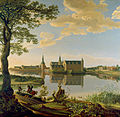Frederiksborg Castle: Difference between revisions
illus |
Spelling/grammar the Palace Lake is named "The Palace Lake" in Danish |
||
| Line 2: | Line 2: | ||
[[Image:Fredriksborg palace.jpg|right|thumbnail|250px|Frederiksborg castle.]] |
[[Image:Fredriksborg palace.jpg|right|thumbnail|250px|Frederiksborg castle.]] |
||
[[Image:Frederiksborg Slot 13-09-07 03.jpg|thumb|250px|The Great Hall (''Riddersalen'').]] |
[[Image:Frederiksborg Slot 13-09-07 03.jpg|thumb|250px|The Great Hall (''Riddersalen'').]] |
||
'''Frederiksborg castle''' is a [[castle]] in [[Hillerød]], [[Denmark]]. It was built as a royal residence for [[Christian IV of Denmark|King Christian IV]], and is now known as [[Frederiksborg Palace#The Museum of national History|The Museum of National History]]. The current building replaced a previous castle erected by [[Frederick II of Denmark|Frederick II]], and is the largest [[Renaissance]] [[palace]] in [[Scandinavia]]. The palace is located on three small islands in the middle of Palace Lake, ([[Danish language|Danish]], '' |
'''Frederiksborg castle''' is a [[castle]] in [[Hillerød]], [[Denmark]]. It was built as a royal residence for [[Christian IV of Denmark|King Christian IV]], and is now known as [[Frederiksborg Palace#The Museum of national History|The Museum of National History]]. The current building replaced a previous castle erected by [[Frederick II of Denmark|Frederick II]], and is the largest [[Renaissance]] [[palace]] in [[Scandinavia]]. The palace is located on three small islands in the middle of Palace Lake, ([[Danish language|Danish]], ''Slotsøen''), and is adjoined by a large, [[baroque]] formal garden. |
||
==History== |
==History== |
||
Revision as of 02:30, 4 September 2011


Frederiksborg castle is a castle in Hillerød, Denmark. It was built as a royal residence for King Christian IV, and is now known as The Museum of National History. The current building replaced a previous castle erected by Frederick II, and is the largest Renaissance palace in Scandinavia. The palace is located on three small islands in the middle of Palace Lake, (Danish, Slotsøen), and is adjoined by a large, baroque formal garden.
History

The oldest parts of the castle date back to 1560, and were built by King Frederick II, after whom the palace is named.
Most of the current palace, however, was built from 1602 to 1620 by Christian IV using Flemish architects, Hans and Lorenz van Steenwinckel, and follows the Dutch style favoured by Christian IV for his new buildings in Copenhagen.
After Christian IV's death in 1648, the palace was used mainly for ceremonial events, primarily the anointing and crowning of the Absolute Monarchs in the palace church. The following Danish kings and queens were crowned here:
- 1671: Christian V and Charlotte Amalie of Hesse-Kassel
- 1700: Frederick IV and Louise of Mecklenburg-Güstrow
- 1721: Anna Sophia, consort of Frederick IV
- 1731: Christian VI and Sophia Magdalena of Brandenburg-Kulmbach
- 1747: Frederick V and Louise of Great Britain
- 1752: Juliana Maria of Brunswick-Wolfenbüttel, consort of Frederick V
- 1815: Frederick VI and Marie of Hesse-Kassel
- 1840: Christian VIII and Caroline Amalie of Schleswig-Holstein
Since 1693 the church has also been used as Knight's Chapel for the Order of the Elephant and the Order of the Dannebrog.
The palace was also used to house the royal family's art collection; as a result, it came to be regarded as a national monument.
In 1720, the Treaty of Frederiksborg was signed here.
In 1850s, the palace was again used as a residence by King Frederick VII. During the night of December 16–17, 1859, while he was in residence, a fire destroyed a large part of the main palace's interior. Reconstruction was funded by public subscription, with large contributions from the King, state and the prominent philanthropist J. C. Jacobsen of Carlsberg Brewery, who also provided funds to establish the The Museum of National History[1] that now occupies Frederiksborg. A large collection of notable paintings by the Danish painter Carl Heinrich Bloch are in the palace. Commissioned for the palace, these paintings largely depict the life of Jesus Christ.
Prince Joachim and Princess Alexandra (now Countess of Frederiksborg) were married in the Palace Church.
The Palace Church


The church, also known as the Chapel of Orders, serves as a local church today, and is a part of the museum on the premises. The coats-of-arms of recipients of the country's royal orders, the Order of the Elephant and the Order of the Dannebrog, are displayed on the walls of the church.
The Museum of national History
The museum houses the country's most important collection of portraits and history paintings.
The Countess of Frederiksborg
Alexandra Christina Manley's title Grevinde af Frederiksborg (Countess of Frederiksborg) refers to her marriage to Prince Joachim of Denmark in Frederiksborg Palace Church. This title was bestowed upon her April 16, 2005 by Queen Margrethe II eight days after the royal couple became officially divorced.
Gallery
-
Frederiksborg Palace by Lazarus Baratta, 1652
-
Frederiksborg Palace, by Christen Købke, 1835
-
Frederiksborg Palace by P.C. Skovgaard, 1841
See also
References
- ^ "Det nationalhistoriske museum - Frederiksborg slot" (in Danish). frederisborgmuseet.dk. Retrieved 4 December 2010.



